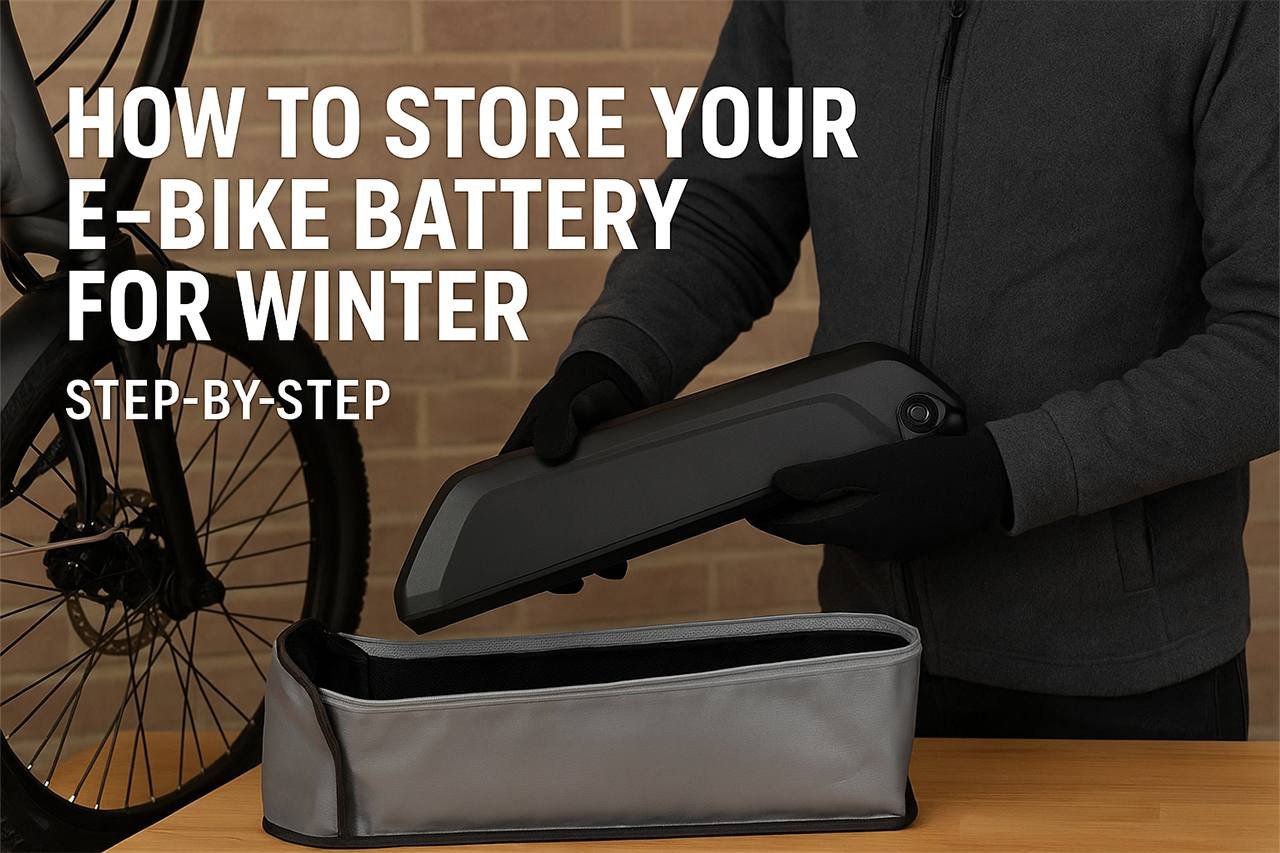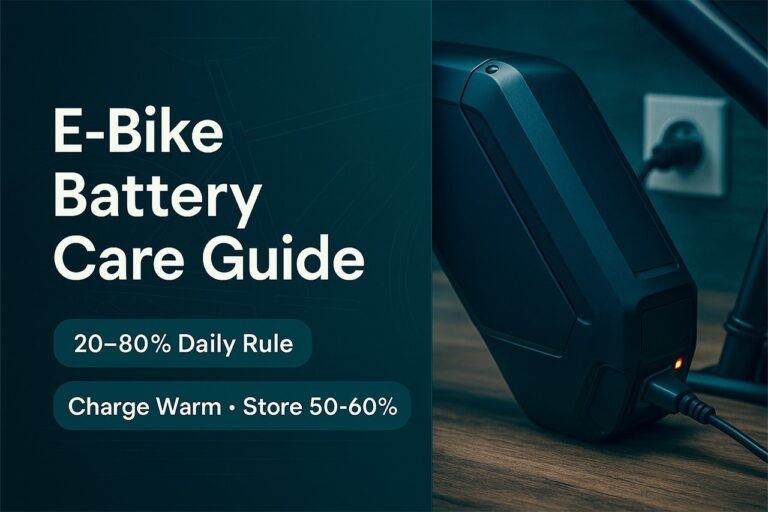
Storing an e-bike battery the right way can easily add years to its useful life, protect your home, and help your bike wake up happy when spring returns. Lithium-ion cells like gentle temperatures, a partial state of charge, and a periodic check-in. Everything below translates that into a simple routine you can actually follow.
Applies to: Most e-bike packs using NMC/NCA lithium-ion cells (36V/48V/52V). If you have LiFePO₄ or a brand-specific instruction, still follow your manual first—then use this guide to fill in the gaps.
Quick Start
- Charge to 50–60% before storage. Don’t leave it full, and never leave it empty.
- Store at 50–68°F (10–20°C) in a dry, stable indoor space. Avoid freezing or hot areas.
- Remove the battery from the bike if possible. Keep it in a fire-resistant bag/box, off the floor, away from flammables.
- Check every 4–6 weeks. If it dips near ~30–40%, top it back up to ~50–60%.
- Never charge a cold battery. If it’s been below 32°F (0°C), let it warm to room temperature for several hours before charging.
- Spring wake-up: Inspect, top to 100% once to balance (if your pack balances at the top), then ride.
Why Winter Storage Matters
Lithium-ion cells age in two main ways:
- Calendar aging: Time itself causes tiny changes in materials. Higher temperatures and higher state-of-charge (SOC) accelerate this.
- Cycle aging: Every charge/discharge cycle adds a little wear. Deep cycling at extremes is tougher on cells.
So our storage goals are straightforward:
- Keep the battery cool but not cold, dry, and partially charged.
- Avoid extremes (too full, too empty, too hot, below freezing).
- Prevent small, continuous drains (anti-theft devices, displays, trackers) from creeping the pack to empty.
Safety First (non-negotiables)
- Don’t charge unattended or overnight while you sleep.
- Keep a smoke alarm in the storage area.
- Store the pack on a non-combustible surface (metal shelf, tile, concrete, or inside a UL-listed battery safe/fire-resistant bag or box).
- No water exposure. Moisture + electronics = corrosion risk.
- If the pack shows swelling, strong solvent smell, hissing, heat, or visible damage, isolate it and contact the manufacturer or a qualified e-bike service center. Do not attempt to charge or use a compromised battery.
- If you must keep the battery on the bike (apartment rules, etc.), remove the key and disable drains (alarm/trackers) or plan a monthly top-up. Ensure the bike is well away from ignition sources and flammables.
Understanding Voltage & SOC
Most e-bikes use:
- 36V packs (10 cells in series, 10s): ~42.0V full, ~37.0V ≈ 50%
- 48V packs (13s): ~54.6V full, ~48.1V ≈ 50%
- 52V packs (14s): ~58.8V full, ~51.8V ≈ 50%
You don’t have to measure pack voltage to store correctly, but if your display or app shows battery percentage, aim for ~50–60% for storage. If you can only see bars, set it around half.
Tip: Many chargers don’t have a “storage mode.” You can still hit 50–60% by timing a partial charge (e.g., from 20% up to ~60%) and unplugging manually.
The Ideal Winter Storage Environment
- Temperature: 50–68°F (10–20°C) is the sweet spot. A little cooler is fine. Avoid below freezing for long periods, and avoid hot spaces (attics, boiler rooms).
- Humidity: <60% RH is a safe target. Use desiccant packs or a dehumidifier if needed.
- Airflow: Normal indoor airflow is fine; no sealed plastic bags (trap moisture).
- Placement: Off the floor (reduces condensation/dust), away from direct sunlight, heaters, or cold exterior walls.
- Containment: Fire-resistant bag/box adds an extra safety layer.
STEP-BY-STEP: Preparing Your Battery for Winter
Follow these in order. You can do everything in under an hour.
Step 1: Note the basics
- Record the model, serial number, and purchase date (photo the label).
- Check your warranty—some brands require certain storage SOC for coverage.
Step 2: Inspect the battery & cradle
- Look for cracks, dents, swelling, loose seams, corrosion, or burn marks on connectors.
- Wiggle the charge port gently—should feel solid.
- If anything feels off, stop and contact the brand/service center.
Step 3: Clean & dry
- Wipe the case with a slightly damp microfiber; dry immediately.
- Clean contacts with a dry cloth or a cotton swab very lightly moistened with isopropyl alcohol (≥90%); let fully air-dry.
Step 4: Set the storage charge
- If currently below ~40%, charge to 50–60%.
- If currently close to 100%, ride a quick loop or run the lights to bring it down to ~60%.
- No storage mode? Time the charge: from empty to full often takes X hours on your charger—use that to estimate the time to reach ~60%.
Step 5: Disable silent drains
- Remove the battery from the bike if possible.
- If you must leave it installed: turn the bike fully OFF, disable alarms/trackers, and lock the key switch (if present).
Step 6: Choose the storage spot
- Indoors, 50–68°F, dry, away from flammables, on a non-combustible surface.
- Place inside a battery safe/fire-resistant bag if you have one.
Step 7: Log it & set reminders
- Note today’s SOC (or voltage) and date.
- Set a recurring reminder every 4–6 weeks to check SOC.
That’s it—you’re winter-ready.
Monthly Winter Routine
- Visual check: Case intact, no odor, no warmth.
- SOC check: If below ~40% (or your brand’s threshold), top back to 50–60%.
- Environment check: No new moisture, dust, or temperature swings.
- Log it: New date + SOC.
Deep winter tip: In very cold garages, move the battery into the house for the season. Freezing storage isn’t instantly catastrophic, but it increases risk and reduces performance. Charging cold cells is the real hazard—avoid it.
Spring Wake-Up: Bringing Your Battery Back Online
When temperatures are consistently above ~50°F (10°C):
- Warm to room temp for several hours before charging.
- Inspect again: Any damage, swelling, or smell? If yes, stop and contact support.
- Balance charge: Many BMS systems balance cells near the top of charge. Do one full, gentle charge to 100% (supervised).
- First ride: Keep it easy. The first cycle may show reduced range—this normalizes after a couple of uses.
- Reset expectations: Cold spring mornings still shrink range; that’s normal.
Charging in Cold Weather (Important)
- Never charge below 32°F (0°C). Charging cold lithium cells can plate lithium—a permanent damage mechanism that also raises safety risk.
- If the battery has been in a cold car/garage, let it sit at room temp (ideally 6–12 hours, depending on pack mass) before charging.
- Charging is safest at 59–77°F (15–25°C), away from flammables, and under supervision.
Special Cases & Brand Nuances
Non-removable batteries
- If accessible, power the bike fully off and disable any drains in settings.
- Plan for a wall outlet nearby for occasional top-ups.
- Keep the entire bike in a suitable environment (same temperature/humidity rules).
Packs with mobile apps (smart BMS)
- Some apps offer storage mode or charge caps (e.g., limit to 80%). Use them.
- If your app shows cell voltages, a healthy 13s (48V) pack at ~50% will show cells around 3.6–3.8V.
LiFePO₄ (LFP) packs
- Often tolerate storage well, but still avoid extremes.
- Storage SOC ~50–70% is common; confirm with the manufacturer.
- LFP handles cold discharge better than many chemistries but still do not charge below freezing.
Long-term storage (>6 months)
- Same rules, just be more diligent with interval checks. Every 4–6 weeks is the bare minimum; monthly is better.
- Expect gradual drift. Top up to 50–60% whenever it drops near 30–40%.
Do’s and Don’ts
Do
- Store at 50–60% SOC.
- Keep it cool, dry, indoors.
- Check monthly and top up as needed.
- Warm to room temp before charging after a cold soak.
- Use a UL-listed charger compatible with your pack.
- Keep the charger and charge port clean and undamaged.
- Mount batteries securely when transporting.
Don’t
- Don’t store full or empty for months.
- Don’t trickle or leave it on the charger indefinitely.
- Don’t charge below 32°F (0°C).
- Don’t store near heaters, stoves, sunny windows, or freezers.
- Don’t ignore damage, smells, or heat—stop and seek service.
- Don’t use off-spec chargers or “fast charge” hacks.
Troubleshooting: Common Winter Storage Issues
“My battery seems dead after winter.”
- Check that the charger is functional (indicator lights).
- Ensure the charger plug fully seats; inspect for debris.
- Some BMS units sleep at very low SOC. A normal, compatible charger should wake it. If it won’t:
- Stop and contact your brand/service center. Avoid DIY jump-starts unless the manufacturer explicitly instructs you—improper wake methods can be unsafe and void warranties.
“Capacity feels lower in spring.”
- Cold temps reduce available capacity. Warm weather restores much of it.
- Do a full balance charge once, then ride 2–3 cycles before judging.
“Charger stops early around 80–90%.”
- Could be cell balancing or charger behavior. Try a full supervised charge once to re-sync. If repeated, have the pack evaluated.
“Rust on contacts.”
- Light oxidation can be cleaned with isopropyl alcohol and a dry swab. Severe corrosion needs professional service—moisture may have entered the pack.
“Battery warms slightly in storage.”
- Ambient warmth is fine; self-heating is not. If the pack is warm to the touch while idle, isolate it on a non-combustible surface and contact support.
Myth-Busting
- “Store on concrete = bad.”
Old myth. Modern packs are sealed. Concrete is fine (and non-combustible). Moisture is the real enemy. - “Keep it fully charged all winter.”
No. High SOC accelerates aging. Partial is healthier. - “Fridge storage is best.”
No. Too cold and too humid. Aim for cool, dry, stable room conditions. - “Trickle charging maintains health.”
Lithium-ion doesn’t want float charging like lead-acid. Unplug once you hit storage SOC.
Storage Cheat-Sheet by Pack Type
- 36V (10s): Full ~42.0V • Store ~37.0–38.0V (~50–60%)
- 48V (13s): Full ~54.6V • Store ~48.0–49.5V (~50–60%)
- 52V (14s): Full ~58.8V • Store ~51.5–53.0V (~50–60%)
If your display only shows %, just aim for half. Voltage is optional and mainly for the technically curious.
For Fleet Owners & Power Users
- Create a storage register per pack: ID, chemistry, purchase date, last service, latest SOC, and next check date.
- Standardize on storage SOC of 55% to simplify training.
- Use smart chargers or timers to cap charge levels.
- Install ventilation + smoke detection in the battery room; keep fire-resistant storage and appropriate extinguishers as your local code requires.
- Rotate packs so none sit unattended beyond 6 weeks without a check.
Environmental & Disposal Notes
- End-of-life packs should go to an approved battery recycler. Don’t landfill, don’t toss in household bins.
- Many brands participate in formal take-back programs; ask your local shop or municipal waste authority for the correct drop-off.
Frequently Asked Questions
How low is too low during storage?
Try not to let it drop below ~30–40%. BMS cutoff usually prevents true zero, but repeatedly bottoming out accelerates aging and can trigger BMS sleep.
Is 80% storage better than 60%?
60% generally ages a bit slower than 80%. That said, anything 40–70% is fine. Consistency beats perfection.
Can I store the charger with the battery?
Yes—just not plugged in. Keep the charger dry and dust-free.
What about storing in a detached garage or shed?
Only if it’s dry, lockable, and remains above freezing most of the time. Otherwise, bring the battery indoors.
Should I lube the battery contacts?
Not usually. If corrosion is a problem in coastal areas, a tiny amount of contact protectant designed for low-voltage electronics might help—avoid anything that attracts dust or becomes gummy.
How often should I replace an e-bike battery?
Most packs last 500–1,000 full cycles (often several years). Good storage can materially extend useful life.
Copy-Paste Checklists
Winter Storage Prep Checklist
- Inspect case, ports, and contacts (no damage, no odor, no heat)
- Clean/dry the exterior and contacts
- Charge/discharge to 50–60%
- Disable bike drains or remove battery from bike
- Place on non-combustible surface in a cool, dry indoor location
- Log date + SOC; set 4–6 week reminder
Monthly Check (4–6 weeks)
- Visual inspection (no swelling/odor/heat)
- SOC still ≥40%? If not, top to 50–60%
- Environment still cool/dry?
- Log date + SOC
Spring Wake-Up
- Warm to room temp
- Visual inspection
- Full, supervised charge to 100% (balance), then unplug
- Easy shakedown ride; reassess range after 2–3 cycles
Final Thoughts
If you remember nothing else: store at 50–60% in a cool, dry place and check monthly. Those two habits do 90% of the work to preserve health, range, and safety. Add a spring balance charge, avoid charging cold, and your pack will likely reward you with years of reliable rides.
Disclaimer: Always follow your manufacturer’s instructions and local safety regulations. This guide provides general best practices for typical consumer e-bike batteries and is not a substitute for brand-specific requirements or professional service where needed.


![How to Change Gears on a Bike: A Beginner’s Step-by-Step Guide [year] How to Change Gears on a Bike: A Beginner’s Step-by-Step Guide [year]](https://goebikelife.com/wp-content/uploads/2023/12/How-to-Change-Gears-on-a-Bike-for-Beginners-768x512.jpg)
![How to Reset Your Electric Bike Battery: A Complete Guide ([year]) How to Reset Electric Bike Battery?](https://goebikelife.com/wp-content/uploads/2025/05/How-to-Reset-Electric-Bike-Battery-768x512.jpg)




